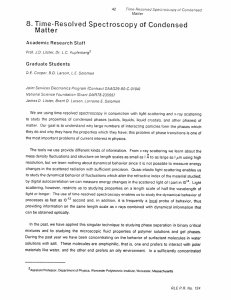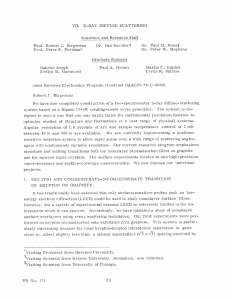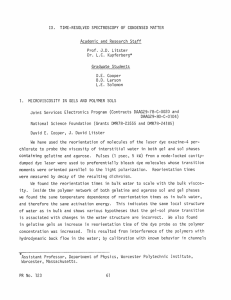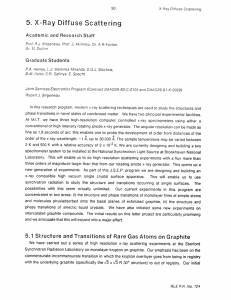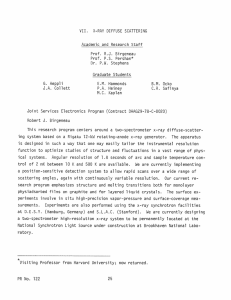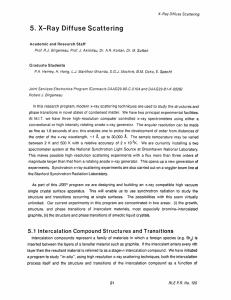9. Optical Spectroscopy of Disordered Materials
advertisement
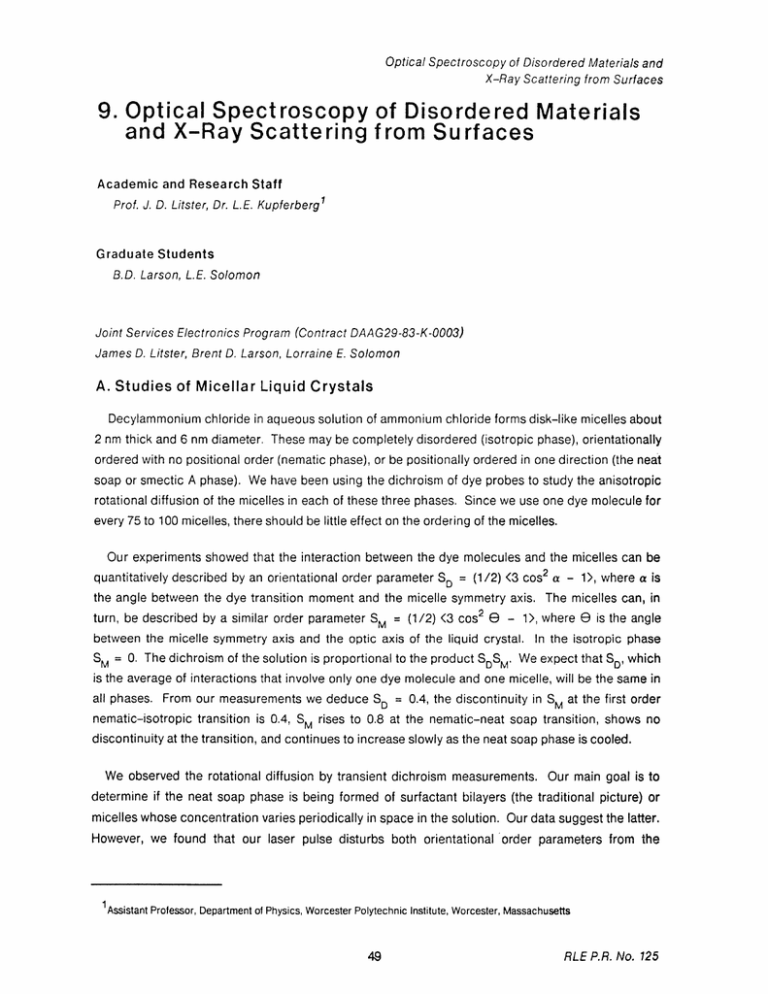
Optical Spectroscopy of Disordered Materials and X-Ray Scattering from Surfaces 9. Optical Spectroscopy of Disordered Materials and X-Ray Scattering from Surfaces Academic and Research Staff Prof. J. D. Litster, Dr. L.E. Kupferberg 1 Graduate Students B.D. Larson, L.E. Solomon Joint Services Electronics Program (Contract DAAG29-83-K-0003) James D. Litster, Brent D. Larson, Lorraine E. Solomon A. Studies of Micellar Liquid Crystals Decylammonium chloride in aqueous solution of ammonium chloride forms disk-like micelles about 2 nm thick and 6 nm diameter. These may be completely disordered (isotropic phase), orientationally ordered with no positional order (nematic phase), or be positionally ordered in one direction (the neat soap or smectic A phase). We have been using the dichroism of dye probes to study the anisotropic rotational diffusion of the micelles in each of these three phases. Since we use one dye molecule for every 75 to 100 micelles, there should be little effect on the ordering of the micelles. Our experiments showed that the interaction between the dye molecules and the micelles can be quantitatively described by an orientational order parameter SD = (1/2) <3 cos 2 a - 1>, where a is the angle between the dye transition moment and the micelle symmetry axis. The micelles can, in turn, be described by a similar order parameter SM = (1/2) <3 cos 2 E - 1>, where e is the angle between the micelle symmetry axis and the optic axis of the liquid crystal. In the isotropic phase SM = 0. The dichroism of the solution is proportional to the product SDSM* We expect that SD, which is the average of interactions that involve only one dye molecule and one micelle, will be the same in all phases. From our measurements we deduce SD = 0.4, the discontinuity in SM at the first order nematic-isotropic transition is 0.4, SM rises to 0.8 at the nematic-neat soap transition, shows no discontinuity at the transition, and continues to increase slowly as the neat soap phase is cooled. We observed the rotational diffusion by transient dichroism measurements. Our main goal is to determine if the neat soap phase is being formed of surfactant bilayers (the traditional picture) or micelles whose concentration varies periodically in space in the solution. Our data suggest the latter. However, we found that our laser pulse disturbs both orientational order parameters from the 1 Assistant Professor, Department of Physics, Worcester Polytechnic Institute, Worcester,Massachusetts RLE P.R. No. 125 Optical Spectroscopy of Disordered Materials and X-Ray Scattering from Surfaces equilibrium values. SD relaxes rapidly and dominates the short time (t < 500 ps) behavior. To answer the question definitively, we are beginning experiments with dyes that have a high singlet to triplet conversion and hence longer excited state lifetimes; these will permit us to observe the much slower (t > 10 ns) motion of the micelles directly. B. Energy Transfer Studies Our goal is to use energy transfer between dye molecules to study short range orientational order of molecules in liquid crystal phases and obtain information to complement that which can only be obtained on much greater length scales by light scattering. We have begun experiments with the laser dyes rhodamine 640 (Rh640) and oxazine 725 (Ox725). As the emission spectrum of Rh640 almost perfectly overlaps the absorption spectrum of Ox725, this pair is ideally suited to energy transfer experiments. Preliminary experiments have been carried out with the dyes dissolved in ethanol. Pure Rh640 has a fluorescence lifetime we measure from time dependent absorption following a bleaching pulse to be 4.0 ns, while that of Ox725 is about 770 ps. When the two dyes are mixed and the Rh640 absorption measured at a wavelength where Ox725 gives no observable signal, the lifetime drops to 2.8 ns indication energy transfer from Rh640 to Ox725 has taken place. The experiments will continue, subject to the constraints of Dr. Kupferberg's teaching duties at Worcester Polytechnic Institute. Publications Litster, J.D. and R.J. Birgeneau, "Liquid Crystals: their Phases and Phase Transitions," Physics Today 35, 26 (1982). Collett, J., L.B. Sorensen, P.S. Pershan, J.D. Litster, R.J. Birgeneau, and J. Als-Nielsen, in of Novel Crystalline-B Phases "Synchrotron X-Ray Study Heptyloxybenzylidene-Heptylaniline (70.7)," Phys. Rev. Lett. 49, 553 (1982). Rosenblatt, C.and J.D. Litster, "Magnetic Birefringence Determination of the Tilt Susceptibility at the Smectic A - Smectic C Phase Transition in Butoxybenzylidene-Heptylaniline," Phys. Rev. A 26, 1809 (1982). Litster, J.D,, "Scattering Spectroscopy of Liquid Crystals," in H.Z. Cummins and A.P. Levanyuk (Eds.), Light Scattering Near Phase Transitions, (North Holland), in press. Birgeneau, R.J., C.W. Garland, Jr., A.R. Kortan, J.D. Litster, M.Meichle, B.M. Ocko, C. Rosenblatt, and L-J. Yu, "The Smectic A - Smectic C Transition: Mean Field or Critical?" Phys. Rev. A 27, 1251 (1983). Safinya, C.R., L.J. Martinez-Miranda, M.Kaplan, J.D. Litster, and R.J. Birgeneau, "High Resolution X-Ray Scattering Study of the Nematic to Smectic-C Transitions in 8S5/7S5 Mixtures," Phys. Rev. Lett. 50, 56 (1983). Litster, J.D., "Structural Studies of Nematic and Smectic Phases," Phil. Trans. Roy. Soc. A309, 145 (1983). Garland, C.W., M. Meichle, B.M. Ocko, A.R. Kortan, L.J. Yu, J.D. Litster, and R.J. Birgeneau, "Critical Behavior at the Nematic-Smectic-A Transition in Butyloxybenzylidine Heptylaniline (40.7)," Phys. Rev. A 27, 3234 (1983). RLE P.R. No. 125 Optical Spectroscopy of Disordered Materials and X-Ray Scattering from Surfaces Kumar, S., L.J. Yu, and J.D. Litster, "Orientation Fluctuations of a Lyotropic Nematic Liquid Crystal Measured by Quasielastic Light Scattering," Phys. Rev. Lett. 50, 1672 (1983). Post, M.V., S.B. Thesis, Department of Electrical Engineering and Computer Science, M.I.T., June 1982. RLE P.R. No. 125 RLE P.R. No. 125 52
